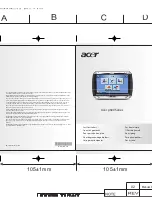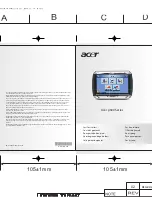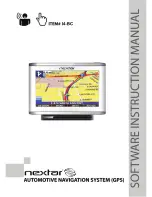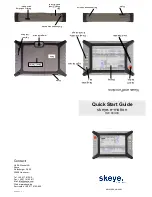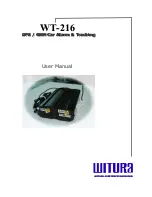
LA000605D © 2007 Navman New Zealand. All rights reserved. Proprietary information and specifications subject to change without notice.
2.1 Electrical connections (SMT pad interface)
The round hole on the front label side of the chip locates pad A1. The pads are designated
A-F and 1-7. Details of the pad layout and numbering are shown in Figure 2-1.
Pad No
Pad Names
Type
Description
A1
RF_IN
I
RF Input 50 ohm
A2
GND
P
RF signal ground return
A3
GND
P
ground
A4
VANT
P
active antenna power input
A5
GPIO15
I/O
reserved
A6
GPIO14
I/O
reserved
A7
RF_ON
O
output to indicate whether the RF section is
enabled (active high)
B1
GND
P
RF signal ground return
B3
VDD_BB
P
baseband power supply input for external
regulator build option - DO NOT CONNECT
B4
GPIO4
I/O
reserved
B5
GPIO13
I/O
reserved
B6
VDD_RTC
P
RTC power supply input for external regulator
build option - DO NOT CONNECT
B7
GPIO1
I/O
reserved
C1
GND
P
ground
C2
TCXO_IN
I
TCXO input for external TCXO build option
- DO NOT CONNECT
C4
BOOT
I
active high to download flash firmware
C5
LNA _EN
O
external antenna enable, active high
D2
FACTORY USE ONLY
reserved
D4
N_GPS_FIX
O
active low when 2D or 3D fix data
available
D5
RXA
I
CMOS level asynchronous input for UART A
D7
TXA
O
CMOS level asynchronous output for UART A
E1
GND
P
ground
E2
GND
P
ground
E4
GPIO2
I/O
reserved
E5
N_RESET
I
master reset, active low
E6
RXB
I
CMOS level asynchronous input for UART B
E7
1PPS
O
1 pulse per second output 1µs wide
F1
PWRIN
P
3.0 - 3.6 V main power supply input
F2
VBATT
P
1.9 - 3.6 V backup battery input
F3
VCC_RF
P
RF power supply output for external regulator
option. Connect as per application circuit.
- Figure 2-2
F4
WAKEUP
I
Push-to-Fix wake-up, active high
F5
N_WAKEUP
O
low output indicates baseband is powered up
- DO NOT CONNECT
F6
TXB
O
CMOS level asynchronous output for UART B
F7
ECLK
I
external clock input, not used
Table 2-1: Jupiter 32 Module pad functions





















